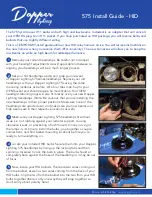
continues upon
subsequent vehicle start-
ups as long as the
malfunction exists. When
the TPMS malfunction
indicator is on, the system
might not be able to
detect or signal under- or
over-inflated tires as
intended.
TPMS malfunctions can occur for a variety of
reasons, including installing replacement or
alternate tires or wheels that prevent the
TPMS from functioning properly. Always
check the TPMS malfunction indicator light
after replacing one or more tires or wheels on
your vehicle to ensure that the replacement
tires or wheels allow the TPMS to continue to
function properly.
NOTE:
If a tire has been replaced or repaired
using a different tire sealant than the one
available from Tesla, and a low tire pressure is
detected, it is possible that the tire sensor has
been damaged. Contact Tesla to have the
fault repaired as soon as possible.
Seasonal Tire Types
Summer Tires
Your vehicle may be originally equipped with
high performance summer tires or all season
tires. Tesla recommends using winter tires if
driving in cold temperatures or on roads
where snow or ice may be present. Contact
Tesla for winter tire recommendations.
WARNING:
In cold temperatures or on
snow or ice, summer tires do not
provide adequate traction. Selecting
and installing the appropriate tires for
winter conditions is important to
ensure the safety and optimum
performance of your Model S.
All-Season Tires
Your Model S may be originally equipped with
all-season tires. These tires are designed to
provide adequate traction in most conditions
year-round, but may not provide the same
level of traction as winter tires in snowy or icy
conditions. All-season tires can be identified
by “ALL SEASON" and/or "M+S” (mud and
snow) on the tire sidewall.
Winter Tires
Use winter tires to increase traction in snowy
or icy conditions. When installing winter tires,
always install a complete set of four tires at
the same time. Winter tires must be the same
diameter, brand, construction and tread
pattern on all four wheels. Contact Tesla for
winter tire recommendations.
Winter tires can be
identified by a mountain/
snowflake symbol on the
tire's sidewall.
When driving with winter tires, you may
experience more road noise, shorter tread life,
and less traction on dry roads.
When equipped with winter tires, refer to the
tire warning label on the door pillar.
Driving in Low Temperatures
Tire performance is reduced in low ambient
temperatures, resulting in reduced grip and
an increased susceptibility to damage from
impacts. Performance tires can temporarily
harden when cold, causing you to hear
rotational noise for the first few kilometers
until the tires warm up.
Using Tire Chains
Tesla has tested and approved Maggie Group
Trak Sport P217 tire chains to increase
traction in snowy conditions. These chains
should only be installed on rear 19" tires. Do
not use chains on 21" tires or on front tires.
The approved tire chains can be purchased
from Tesla.
When installing tire chains, follow the
instructions and warnings provided by the tire
chain manufacturer. Mount them evenly and
as tight as possible.
When using tire chains:
Tire Care and Maintenance
184
MODEL S OWNER'S MANUAL
















































